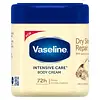What's inside
What's inside
 Key Ingredients
Key Ingredients

 Benefits
Benefits

 Concerns
Concerns

 Ingredients Side-by-side
Ingredients Side-by-side

Water
Skin ConditioningParaffinum Liquidum
EmollientPetrolatum
EmollientStearic Acid
CleansingGlycerin
HumectantGlyceryl Stearate
EmollientCetyl Alcohol
EmollientPhenoxyethanol
PreservativePotassium Hydroxide
BufferingMethylparaben
PreservativeCarbomer
Emulsion StabilisingParfum
MaskingPropylparaben
PreservativeXanthophylls
Skin ConditioningXanthan Gum
EmulsifyingDisodium EDTA
Potassium Carbonate
BufferingPropylene Glycol
HumectantLactic Acid
BufferingAvena Sativa Straw Extract
Skin ConditioningTocopherol
AntioxidantSodium Chloride
MaskingSodium Sulfate
Glucose
HumectantSodium Benzoate
MaskingPotassium Sorbate
PreservativeCitric Acid
BufferingAlpha-Isomethyl Ionone
PerfumingAmyl Cinnamal
PerfumingBenzyl Alcohol
PerfumingCinnamyl Alcohol
PerfumingCitronellol
PerfumingCoumarin
PerfumingGeraniol
PerfumingHexyl Cinnamal
PerfumingLimonene
PerfumingLinalool
PerfumingCI 47005
Cosmetic ColorantWater, Paraffinum Liquidum, Petrolatum, Stearic Acid, Glycerin, Glyceryl Stearate, Cetyl Alcohol, Phenoxyethanol, Potassium Hydroxide, Methylparaben, Carbomer, Parfum, Propylparaben, Xanthophylls, Xanthan Gum, Disodium EDTA, Potassium Carbonate, Propylene Glycol, Lactic Acid, Avena Sativa Straw Extract, Tocopherol, Sodium Chloride, Sodium Sulfate, Glucose, Sodium Benzoate, Potassium Sorbate, Citric Acid, Alpha-Isomethyl Ionone, Amyl Cinnamal, Benzyl Alcohol, Cinnamyl Alcohol, Citronellol, Coumarin, Geraniol, Hexyl Cinnamal, Limonene, Linalool, CI 47005
Water
Skin ConditioningParaffinum Liquidum
EmollientGlycerin
HumectantCarbomer
Emulsion StabilisingPotassium Cetyl Phosphate
EmulsifyingPhenoxyethanol
PreservativeCetyl Alcohol
EmollientSodium Polyacrylate
AbsorbentCaprylyl Glycol
EmollientHydrogenated Palm Glycerides
EmollientSodium Hydroxide
BufferingButyrospermum Parkii Butter
Skin ConditioningDisodium EDTA
Avena Sativa Kernel Oil
Skin ConditioningMagnesium Aspartate
Skin ConditioningZinc Gluconate
Skin ConditioningCopper Gluconate
Skin ConditioningWater, Paraffinum Liquidum, Glycerin, Carbomer, Potassium Cetyl Phosphate, Phenoxyethanol, Cetyl Alcohol, Sodium Polyacrylate, Caprylyl Glycol, Hydrogenated Palm Glycerides, Sodium Hydroxide, Butyrospermum Parkii Butter, Disodium EDTA, Avena Sativa Kernel Oil, Magnesium Aspartate, Zinc Gluconate, Copper Gluconate
 Reviews
Reviews

Ingredients Explained
These ingredients are found in both products.
Ingredients higher up in an ingredient list are typically present in a larger amount.
Carbomer is a polymer of acrylic acid. Its main role is to create a gel consistency.
A high amount of carbomer can cause pilling or balling up of products. Don't worry, most products contain 1% or less of carbomer.
Cetyl Alcohol is a fatty alcohol. Fatty Alcohols are most often used as an emollient or to thicken a product.
Its main roles are:
Though it has "alcohol" in the name, it is not related to denatured alcohol or ethyl alcohol.
The FDA allows products labeled "alcohol-free" to have fatty alcohols.
Learn more about Cetyl AlcoholDisodium EDTA plays a role in making products more stable by aiding other preservatives.
It is a chelating agent, meaning it neutralizes metal ions that may be found in a product.
Disodium EDTA is a salt of edetic acid and is found to be safe in cosmetic ingredients.
Learn more about Disodium EDTAGlycerin is already naturally found in your skin. It helps moisturize and protect your skin.
A study from 2016 found glycerin to be more effective as a humectant than AHAs and hyaluronic acid.
As a humectant, it helps the skin stay hydrated by pulling moisture to your skin. The low molecular weight of glycerin allows it to pull moisture into the deeper layers of your skin.
Hydrated skin improves your skin barrier; Your skin barrier helps protect against irritants and bacteria.
Glycerin has also been found to have antimicrobial and antiviral properties. Due to these properties, glycerin is often used in wound and burn treatments.
In cosmetics, glycerin is usually derived from plants such as soybean or palm. However, it can also be sourced from animals, such as tallow or animal fat.
This ingredient is organic, colorless, odorless, and non-toxic.
Glycerin is the name for this ingredient in American English. British English uses Glycerol/Glycerine.
Learn more about GlycerinParaffinum Liquidum is also known as liquid paraffin. It is a type of highly refined mineral oil.
Like other oils, Paraffinum Liquidum has emollient properties. Emollients help soothe and soften the skin. By creating a barrier to trap moisture within, emollients help keep your skin hydrated.
Paraffinum Liquidum does not irritate the skin and is non-comedogenic.
Learn more about Paraffinum LiquidumPhenoxyethanol is a preservative that has germicide, antimicrobial, and aromatic properties. Studies show that phenoxyethanol can prevent microbial growth. By itself, it has a scent that is similar to that of a rose.
It's often used in formulations along with Caprylyl Glycol to preserve the shelf life of products.
Water. It's the most common cosmetic ingredient of all. You'll usually see it at the top of ingredient lists, meaning that it makes up the largest part of the product.
So why is it so popular? Water most often acts as a solvent - this means that it helps dissolve other ingredients into the formulation.
You'll also recognize water as that liquid we all need to stay alive. If you see this, drink a glass of water. Stay hydrated!
Learn more about Water